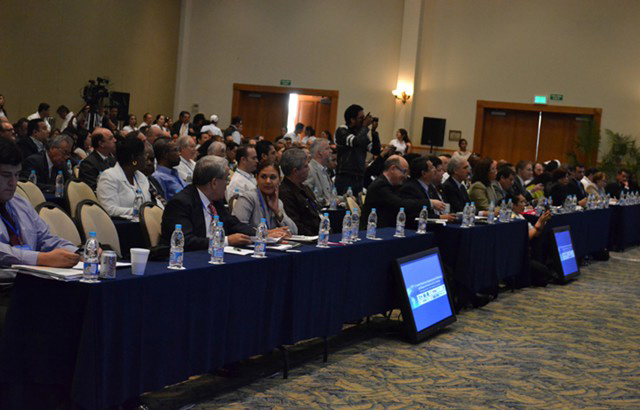THEMATIC SESSIONS OVERVIEW
 Photo: Abril Rojas / SEGOB México |
general Instructions
|
_______________________________________________________________________________________________
1. Regional Platform Sessions 2012
Sessions |
Sessions Goals |
Sub-subjects per Session |
Coordinating Institution (Underlined) |
Mechanisms, tools and instruments towards a disaster risk reducction framework beyond 2015
|
Contribute with the discussion of a new post-HFA DRR framework and identify areas of agreement or general guidelines regarding the tendencies, challenges and emerging solutions, connection with other important areas such as climate change adaptation, sustainable development and poverty eradication, environment and disaster preparedness, that could be reached as inputs to be considered by the participants of the Global Platform for DRR IV Session in Geneva, Switzerland, 2013. |
|
UNISDR
Key partners : 8-9 partners from different sectors |
Public policies for DRR at national, regional and continental level
|
The goal of this session will be to synthesize through the discussion and review of concrete experiences, critical points in successful processes followed by the countries towards the development of national and regional policies that had generated important changes and progresses regarding the integration of DRR to development. Beyond the concrete experiences, the discussion will aim to identify a group of elements and critical steps within the national or regional policy formulation processes that had been successfully implemented and could be followed as guidelines to formulate a roadmap for a plan of action in countries and sub-regions, in order to tackle underlying risk factors within the sub-regional and national planning processes towards the fulfillment of the HFA priorities. |
|
CEPREDENAC
Key partners: CAPRADE, REHU,CDEMA |
Public investment and financial tools for disaster risk reduction
|
To share experiences at local, national and regional level concerning different incorporation processes of DRR and CCA within the Public Investment National Systems, the Insurance and Financial risk transfer market systems, as well as funds or financial instruments for financial security in case of disaster, expecting to establish a success criteria linked to such experiences, identifying gaps and challenges to increase the relevance of DRR within the mechanisms and systems above mentioned, as well as recommendations for its implementation in the region. |
|
IDB, BM
Key partners: México, Perú, Costa Rica, Panamá, PNUD, Honduras, GIZ. |
Civil society participation in disaster risk reduction
|
Identify and promote processes and mechanisms of civil society and its linkages to public policies for DRR. Identify the current situation, barriers and limitations among them and how to promote its actions to favor DRR and humanitarian relief.
|
|
Chile, IFRC |
Technical cooperation for disaster risk reduction
|
|
|
PNUD, OEA
Key partners: SEGIB. |
Urban Risk in the Americas: A challenge for achieving the sustainable development goals
|
The session goal will be to promote the political commitment of local and national governments towards the urban risk reduction through:
|
|
FLACMA, UNISDR.
Key partners : UN HABITAT, ICLEI, IFRC, Thematic Platform |
2. Parallel Events
a) Assessment of extreme events recovery processes with Haiti and Chile as a base. Reconstruction and early recovery (PNUD, WB, IFRC)
b) Education and DRR (UNICEF, PLAN, UNESCO)
c) Probabilistic Models (WB)
d) Financial instruments for risk management (WB)
3. "Ignite Stage":
Presentations during the whole day of projects and new Disaster Risk Reduction initiatives: "15 minutes to ignite a long lasting communication". The IGNITE Stage, is an space where the Regional Platform participants will have 15 minutes to present a project or initiative about Disaster Risk Reduction. The goal of this space is to expand the range of subjects discusses within the Regional Platform that go beyond those presented in the main sessions and parallel events.